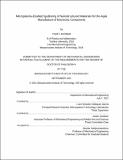Microplasma-Enabled Sputtering of Nanostructured Materials for the Agile Manufacture of Electronic Components
Author(s)
Kornbluth, Yosef S.
DownloadThesis PDF (3.035Mb)
Advisor
Velasquez-Garcia, Luis Fernando
Jacobson, Joseph
Terms of use
Metadata
Show full item recordAbstract
Additive manufacturing has revolutionized the low-volume manufacturing space; for example, polymers can be extruded and joined together to produce arbitrary shapes at the push of a button. However, this revolution is primarily confined to thermoplastics, and more broadly, to structural materials. The ability to add electronic capabilities to these printed shapes would greatly enhance their utility. Unfortunately, most additive manufacturing methods for conductive features do not produce high-quality films, or require processing that can damage printed surfaces.
Cleanroom technology is unmatched in its ability to produce high-resolution, high-quality interconnects and electronic features, but it has rigid requirements. The best results require precision equipment, tightly controlled environments, and are limited to patterning planar wafers and removing unwanted material to produce the desired patterns.
This thesis develops and demonstrates the capabilities of a microplasma-based atmospheric-pressure sputterer, which combines the strengths of both. This microsputterer was developed in order to achieve a direct-write method to deposit arbitrary patterns of electronics-quality thin films for additive manufacturing at room temperature. It uses a sputtering plasma, scaled down to millimeter scale and operated at atmospheric pressure, without the benefit of pre- or post-processing, and with a minimally controlled environment. Process parameters’ impact on the material and manufacturing properties (i.e., adhesion, conductivity, resolution, speed) of the deposits are discussed.
The results of this thesis include near-bulk electrical conductivity for gold films with sub-millimeter resolution and significantly better adhesion than traditionally sputtered films, and alumina films with a breakdown strength that surpasses the state of the art. The printer’s multimaterial capabilities and control over the sheath gas will allow for the creation of objects made of different materials with different electrical properties. This capability allows for the demonstration of practical applications that showcase the printer’s capabilities, including an ultrathin capacitor, produced entirely through microplasma sputtering.
Date issued
2021-09Department
Massachusetts Institute of Technology. Department of Mechanical EngineeringPublisher
Massachusetts Institute of Technology